For this campaign, I will be using the American Tank Ace module for Vassal, created by Greg Amos. The module is a fantastic tool for playing the game on the computer, which makes the combined effort of generating the narrative that much easier.
I will be using ChatGPT to generate the narrative based upon description prompts of the game action, with a final editting pass done by me. Additionally, Vassal screenshots as well as AI renders made by MidJourney will be used for visual flair.
Training at Fort Knox
Location: Fort Knox, Kentucky, United States of America
Date: Winter-Spring, 1944.
As winter surrendered to spring, the crew of the Sherman tank “Copperhead” engaged in a rigorous and comprehensive phase of basic training at Fort Knox, Kentucky. The training grounds echoed with the harmonious blend of steel meeting steel and the assertive voices of instructors, as the crew members threw themselves into the demanding realm of tank warfare.
Corporal William Anderson, whose previous experience as a factory machinist revealed a unique mechanical acumen, honed his skills towards mastering the intricacies of the tank’s weaponry. His gunnery training results displayed an encouraging, albeit average, progression. Simultaneously, Corporal James McAllister, a relentless individual shaped by a mechanical background, confronted the challenge of maneuvering the tank. Although his dedication was unmistakable, his performance in driver training underscored the need for further refinement.
Private Daniel Martinez, exuding an infectious enthusiasm, encountered a momentary setback during a training exercise when his tank became ensnared in the unrelenting grip of mud. Nevertheless, his unwavering resolve to master tank operations remained undaunted, a testament to his dedication.
The crew’s collective weapons training yielded average results, highlighting an area where improvement is warranted. This aspect, integral to the crew’s proficiency, emerged as a focus for advancement.
Amidst the training period, Staff Sergeant Benjamin Caldwell emerged as an exemplar of dedication. Opting to invest additional hours in study rather than indulging in leisure activities, he immersed himself in the multifaceted dimensions of tank warfare tactics and strategy. This unorthodox approach bore fruitful results, elevating him to a central role in the crew’s development.
As the weeks unfolded, the crew’s transformation was a nuanced symphony of tenacity and determination, a crescendo of progress amidst the routine. Departing from Fort Knox, the crew members stood prepared to embark on a collective journey that would not only test their individual skills but also fortify the bonds that melded them into an adept and cohesive unit, poised to confront the challenges that awaited them beyond the training grounds.
Game Note:
**American Tank Ace** opens with dice rolls to demonstrate how the player’s commander and crew performed in training at Fort Knox. Successful rolls can allow future discounts to the experience cost when purchasing specific skills. Unfortunately, the crew’s training dice rolls left a lot to be desired.
- Gunnery Training: 10, 5, 10
- Driver Training (-1 trainee modifier): 5, 5
- Weapons Training: 3, 8, 6
For the optional choice, I elected to have the commander take Extra Study Time to receive a -1 EXP discount on the Expert skill. The other options were to receive a Stamina marker, which would help on the first KIA or SW wound result the commander received, or to carouse and receive +1 Prestige and a +1 Dice modifier on my next promotion.
Normandy
First Mission – Movement to Contact
Location: Normandy, France
Date: June 10th, 1944
Weather: Rain
Terrain: Thick Boccage
On the rain-soaked morning of June 10th, 1944, just a day after arriving in Normandy, France, Charlie Company and the crew of the Sherman tank “Copperhead” embarked on their inaugural mission in the war-ravaged landscape of Normandy. The persistent rain only added to the grim atmosphere, casting a somber pall over the undulating terrain characterized by the thick and unforgiving bocage.
Assigned to undertake a movement-to-contact operation, the “Copperhead” was tasked with spearheading alongside 2nd and 3rd Platoons, advancing cautiously through the treacherous bocage. The initial stages of the mission were marked by an eerie silence, punctuated only by the rhythmic patter of raindrops against the steel hull of the tank.
As the “Copperhead” and Charlie Company pressed forward, the dense bocage obscured visibility, rendering the surroundings an intricate labyrinth. Suddenly, the tension was shattered as the crew found themselves confronted with the stark reality of combat. At close quarters, they made contact with a company of formidable Fallschirmjäger, renowned elite German soldiers, renowned for their tenacity and skill.
The engagement unfolded with a stunning intensity. The crew of the “Copperhead” found themselves facing a dire situation, with two squads of Fallschirmjäger directly engaging them. The audacious enemy had positioned themselves meticulously, one squad supported by the menacing presence of a Hetzer tank destroyer. The Hetzer and one squad of Fallschirmjäger were positioned squarely ahead, while the second squad lurked ominously to the crew’s ten o’clock, ready to spring their deadly trap.
Game Note:
I rolled for my first mission setup only to end up with what could be a very challenging first mission for the rookie crew. A **1** on the Terrain Roll had the battle occuring in Boccage, which forces everything to Close Range, while the **5** on my Weather Roll resulted in **Rain**, which adds a **+1** modifier to many ranged attack rolls. A Hetzer and 2 Elite quality Infantry were the generated enemies, with the infantry coming in the form ofFallschirmjäger.
I had elected to begin the mission with a round of White Phosphorous loaded in the main gun, and the driver and assistant driver both buttoned up because of the close range contact forced by the Boccage. My hope was to quickly get a shot on the Hetzer with the WP round which would leave grid B under smoke, if a lucky shot didn’t take it out.
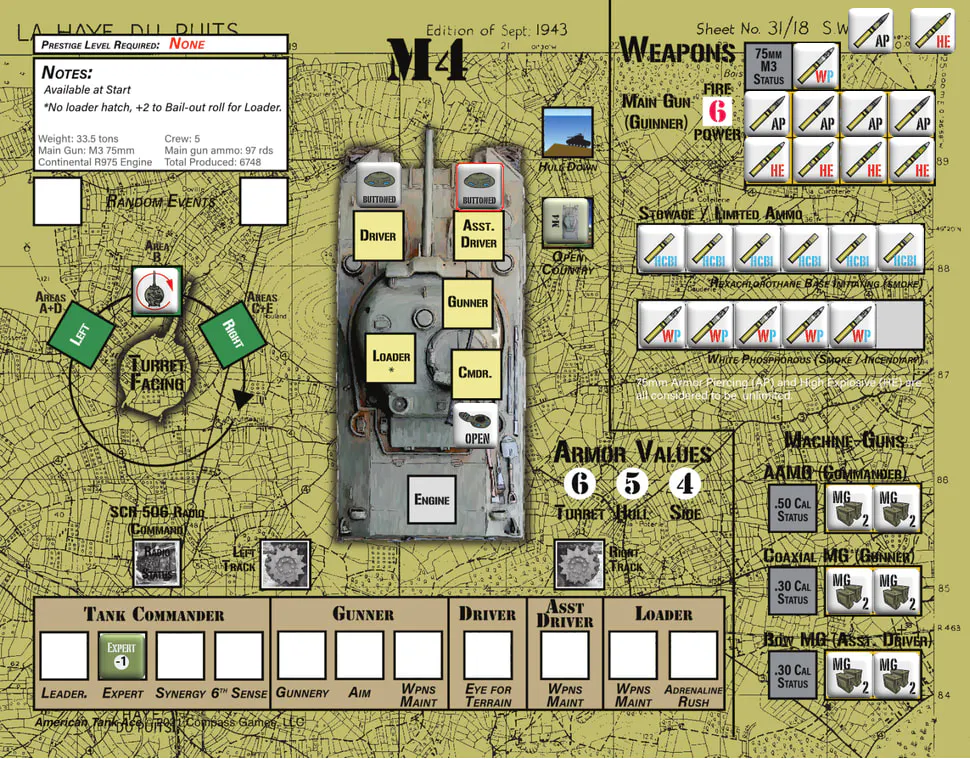
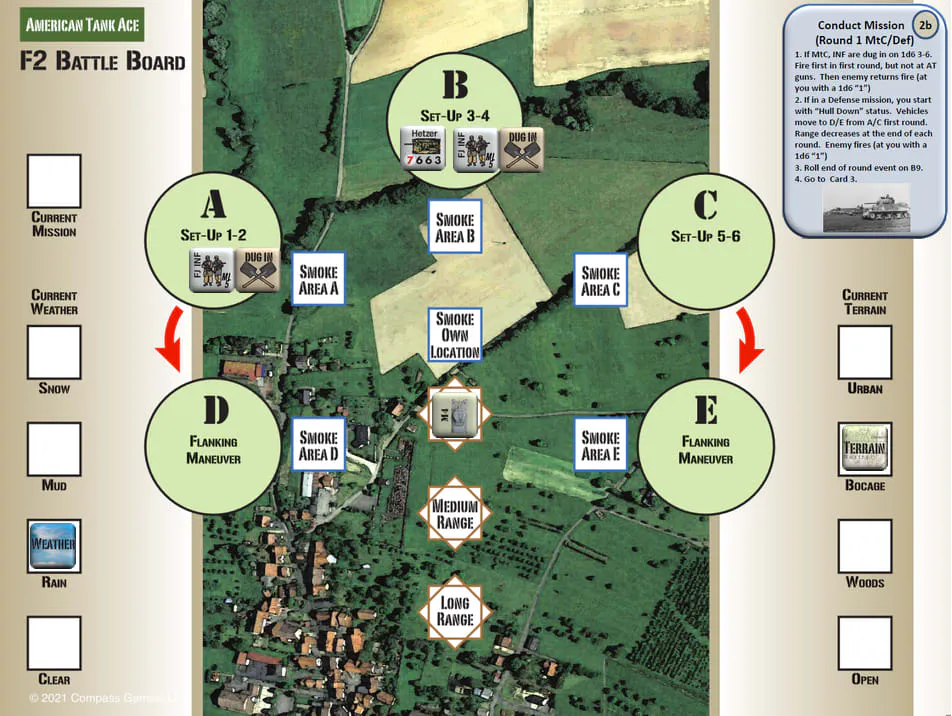
Round 1
At the start of the engagement, the crew of the Sherman tank “Copperhead” executed a sequence of rapid and calculated maneuvers. As the tense confrontation unfolded, the crew demonstrated exceptional coordination and adaptability, underscoring their prowess in the heat of combat.
Responding to the Staff Sergeant Caldwell’s orders, gunner William Anderson initiated a precision strike by firing a white phosphorous round at the advancing Hetzer tank. The projectile found its mark with uncanny accuracy, piercing the Hetzer‘s hull and triggering a catastrophic explosion that engulfed the area in a thick blanket of smoke. The immediate destruction of the Hetzer not only neutralized a potent threat but also provided a critical moment of respite for the crew.
Seizing the opportunity, the gunner seamlessly transitioned to loading an Armor Piercing round into the main gun, priming the tank for subsequent engagements. Concurrently, the Sergeant Caldwell directed the driver to execute a strategic withdrawal, skillfully maneuvering the “Copperhead” in reverse to create a safe distance from the remaining infantry squads. The successful execution of this maneuver was a testament to the crew’s proficiency and teamwork, allowing them to reposition and reassess the evolving battlefield.
Yet, as the crew retreated and reoriented, a new challenge emerged. The vigilant commander spotted the arrival of enemy reinforcements amid the lingering smoke. A StuG IIIG emerged directly ahead, its ominous presence shrouded by the smoke of the white phosphorous round as well as the Hetzer‘s burning wreck, while a formidable Panzer VG tank emerged to the front left. The crew’s momentary relief dissipated as the stark reality of the battle’s fluidity became all too clear.
Game Note:
Each round, the tank commander is allowed to give two orders. For Round 1, I elected to issue a fire order to the Gunner and have them fire the loaded WP round at the Hetzer in Zone B. The WP round leaves smoke in the zone whether it hits or misses, which would allow a potential miss to still provide some defense.
The Roll to fire was: 5 + 1 (Rain) + 1 (Close Range) = 7 – HIT!!! – Hull armor struck!
The Roll on the penetration chart was: 7 = DE – Hetzer Destroyed!
For my second order, I elected to order the driver to back up to Medium Range since the Boccage terrain had forced us to start at Close Range. A roll of 5 on the Immobilization check allowed us to Pass with flying colors.
A roll of 3 and 4 resulted in both Fallschirmjäger infantry units to target other forces adjacent to The Copperhead.
Round 1 closed with an Event Check and I rolled for GE Reinforcement in the form of a StuG IIIG SPG in Zone B and a Pz VG Tank in Zone A. Fortunately, the StuG IIIG would begin in a Smoke filled zone, which would provide some cover.
Here is the board layout after Round 1 was completed:
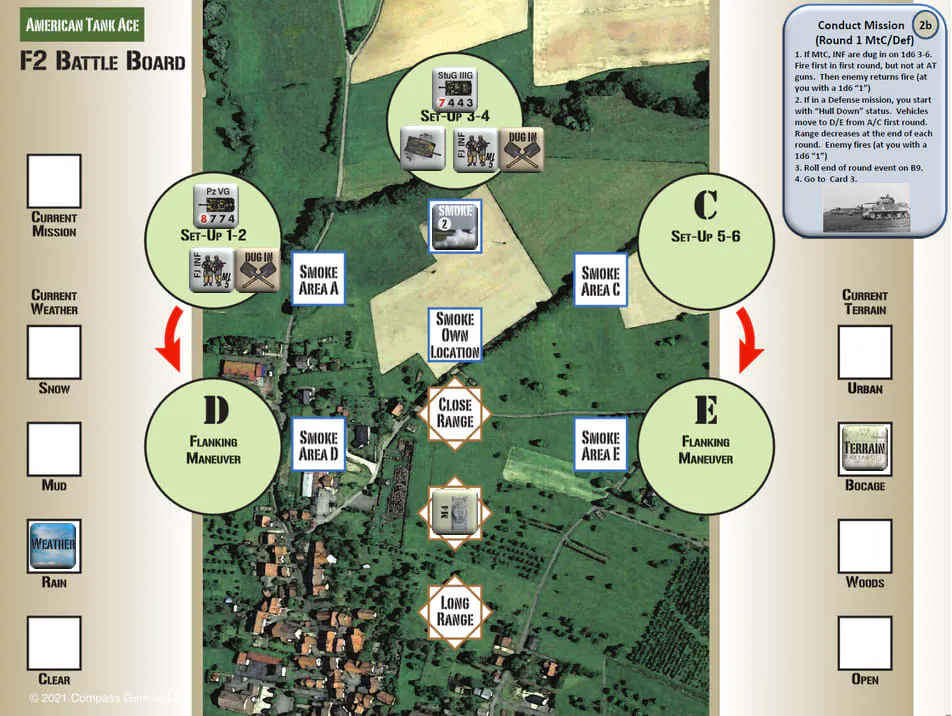
Round 2
As the acrid smoke from the earlier white phosphorous round began to dissipate, the battlefield revealed a rapidly shifting tableau of engagements. The infantry squads remained preoccupied with other sectors of the front lines, which diverted their attention away from the “Copperhead.”
The StuG IIIG set its sights on the “Copperhead”. As the StuG’s turret ominously rotated towards the tank, Staff Sergeant Benjamin Caldwell, in a decisive and daring move, ordered the gunner, Corporal William “Bullseye” Anderson, into action. The initial shot from the “Copperhead” missed its target, a tense moment that tested the crew’s mettle. Undeterred by the setback, Staff Sgt. Caldwell issued another order, directing the gunner to take another shot with an Armor Piercing (AP) round.
With precision honed through training and experience, Bullseye’s second shot found its mark, striking the StuG’s turret with deadly accuracy. The resounding impact heralded the destruction of the StuG IIIG, a testament to the crew’s unwavering determination and skill. The tank’s turret was silenced before it could unleash its formidable firepower upon the “Copperhead.”
The newly arrived Panzer VG eagerly advanced on allied forces to the left of the “Copperhead”, its menacing presence was accentuated by the rumble of its tracks and the weight of its reputation. The infantry squad positioned near the Panzer VG, however, was met with a punishing barrage from the same allied forces the tank was now engaging. The relentless counterattack forced the infantry to hastily retreat, leaving the Panzer exposed but undeterred.
Game Note:
At the start of Round 2, the Smoke-2 in Zone B degraded to Smoke-1, which reduced the impact that the smoke provided to fire in to or out of that zone.
- FJ Infantry – (Zone A): 3 – Targets other forces.
- Pz VG – (Zone A): 5 – Targets other forces.
- FJ Infantry – (Zone B): 2 – Targets other forces.
- StuG IIIG – (Zone B): 1 – Targets COPPERHEAD!
I elected to place a fire order on the StuG IIIG as it was already targeting Copperhead. With the player’s actions happening first, a lucky shot could take out the tank destroyer before it had a chance to fire upon Copperhead in return. I chose another AP round as the reload option on the fire order.
My Roll to fire was: 5 + 1 (Rain) + 1 (Smoke-1) = 7 – Miss!. (Needed 2-6 at Medium Range!).
With the above shot missing, I elected to repeat the order as my second action of the turn.
My Roll to fire was: 2 + 1 (Rain) + 1 (Smoke-1) – 1 (Previous Target) = 3 – Hit! – Turret hit!
The Roll on the penetration chart was: 7 = DE – StuG IIIG Destroyed!
The two infantry and Pz VG were targeting other forces so took no action against Copperhead. The Pz VG moved from Zone A to Zone D.
Round 2 closed with the Event Check and I rolled a 9 – (DE one random GE Inf). A random dice roll selected the FJ Infantry in Zone A as the destroyed target.
Here is the board layout after Round 2 was completed:
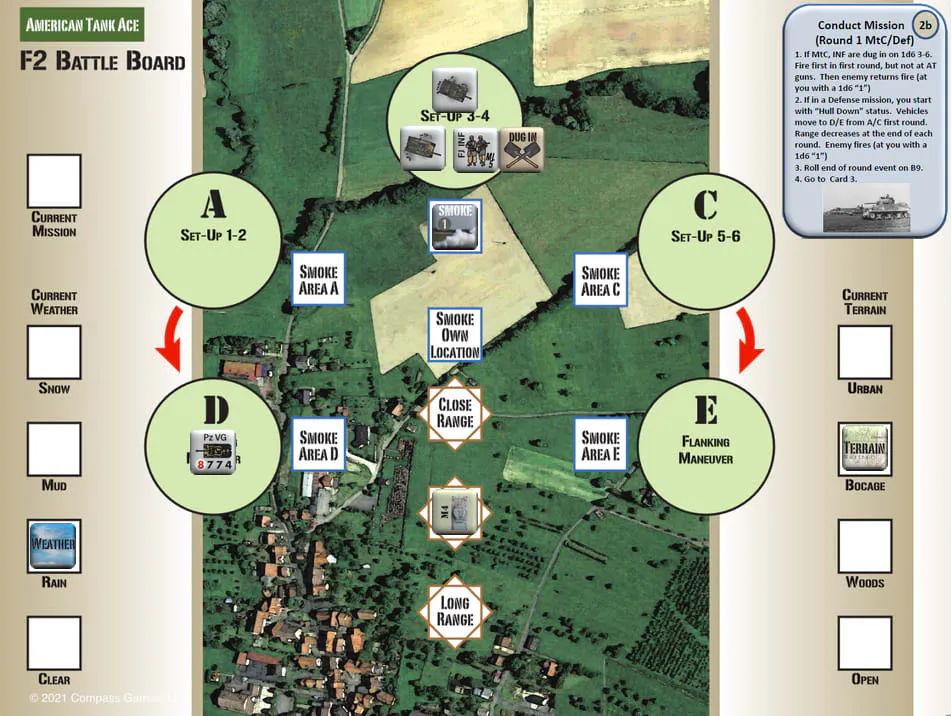
Round 3
As the lingering haze of the white phosphorous dissipated entirely, the battlefield remained a theater of relentless action. The remaining infantry group continued their furious engagement with allied forces to the left of the Sherman tank “Copperhead.” The dense thicket of combat was further complicated by the ongoing exchange between the allied troops and the Panzer VG, whose attention was firmly diverted away from the “Copperhead.”
Staff Sergeant Benjamin Caldwell wasted no time in celebrating the successful destruction of the StuG IIIG. With an unswerving determination to maintain the momentum, he swiftly issued orders to Corporal William “Bullseye” Anderson, the skilled gunner. The directive was straightforward yet crucial – fire an Armor Piercing (AP) round at the Panzer VG, exploiting an opportune angle presented by the tank’s recent movement.
With deft precision, Bullseye maneuvered the turret, aligning it to the left in an attempt to target the exposed Panzer. The first shot, however, failed to find its mark, underscoring the unpredictability of combat dynamics. “Bullseye” quickly loaded the last AP Round from the ‘ready rack’, in anticipation of another shot.
Staff Sgt. Caldwell’s tactical acumen remained unyielding. Understanding the importance of positioning, he ordered the driver, Corporal James “Jimmy” McAllister, to initiate a leftward rotation of the tank’s hull while angling the front toward the Panzer VG. The calculated maneuver aimed to minimize the vulnerable areas and reducing the firepower advantage of the superior Panzer VG.
The Panzer VG, having finally taken note of the “Copperhead’s” presence, swiveled its turret to engage the Sherman. However, the enemy’s shot went wide, missing its target by a margin. In that fleeting moment, the crew’s strategic decisions and quick responses proved pivotal.
Amidst this intense exchange, the battlefield was further plunged into chaos by a sudden German artillery barrage. The shattering impact of artillery fire swept across the allied lines, forcing Staff Sgt. Caldwell to take evasive action by button up his hatch. Staff Sgt. Caldwell sustained a light wound from debris and shrapnel before he could successfully close the hatch.
With the Panzer VG’s full attention on them, the crew of the “Copperhead” would need to think fast in order to survive the next few moments!
Game Note:
At the start of Round 3, the Smoke-1 lingering in Zone B degrades completely.
- Pz VG – (Zone A): 5 – Targets other forces.
- FJ Infantry – (Zone B): 4 – Targets other forces.
Sinze the Pz VG moved to Zone D last turn, the first time firing upon it offers a flanking shot, which causes the hit to strike the side armor instead of the front or turret. I elected to use my first action to issue a fire order to take advantage of this, with the last AP round in the ‘ready rack’ chosen as the reload option. The turret would need to turn to target the Pz VG, which means I am only allowed on fire order this turn, unlike the previous turns where I was targeting units in the forward areas.
My Roll to fire was: 9 + 1 (Rain) = 10 – Miss!.
The miss was unfortunate and now drew the attention of the Pz VG ahead of it’s own turn. Since I could not issue a second fire order due to turret movement, I elected to issue an order to Angle the Hull toward Zone D. The Pz VG could still penetrate my front armor on a hit but this allowed a slightly increased change of surviving a shot.
The Pz VG roll to fire was: 10 + 1 (Rain) = 11 – Miss!.
Round 3 closed with an Event Check and I rolled 4 – (GE Artillery Attack) with a subsequent roll of 3 (6 – 3 for Artillery), which resulted in a B result that forced the commander to button up and take a Wound Check – (Roll 7 – Light Wound). The Driver and Assistant Driver started buttoned up so did not need to Wound Check. Per the errata, Immobilization only occurs on a 0 or less so “Copperhead” remained mobile going in to the next round.
Round 4
In the midst of the tumultuous theater of combat, the remaining infantry squad remained fervently engaged with allied forces, their attention consumed by the volatile front lines. The Sherman tank “Copperhead,” however, bore the brunt of the unfolding events. Staff Sergeant Benjamin Caldwell, now buttoned up inside the tank’s protective confines, navigated the whirlwind of chaos with unwavering resolve.
With the ‘ready rack’ nearly depleted of Armor Piercing rounds, Staff Sgt. Caldwell recognized the urgency of the moment. He directed Corporal William “Bullseye” Anderson, the unerring gunner, to fire another Armor Piercing (AP) round at the Panzer VG. The crew’s fortunes now rested on the gunner’s precision, yet the shot proved elusive as the round missed its target.
As the Panzer VG seized the opportunity to retaliate, the “Copperhead” found itself in the crosshairs of the enemy. The enemy tank’s shot found its mark, striking the Sherman’s front hull armor with devastating accuracy. The force of the impact was catastrophic, rendering the tank instantly incapacitated and claiming the life of the driver, Corporal James “Jimmy” McAllister. Despite the harrowing blow, the crew’s fortune held as no fire ignited within the tank.
As the realization of the tank’s destruction settled in, the crew acted with remarkable swiftness. The surviving members managed to bail out from the smoldering remains, enduring only minimal wounds in the process. Private Michael “Grunt” Thompson, the loader, sustained a shrapnel injury through his arm. While their tank lay in ruin, the crew’s indomitable spirit propelled them to retreat towards the friendly lines, leaving behind the smoldering remnants of the “Copperhead.”
Game Note:
At the start of Round 4, there is no more smoke on the battlefield.
- Pz VG – (Zone A): Already Targeting “Copperhead”
- FJ Infantry – (Zone B): 2 – Targets other forces.
The commander’s Light Wound means I can only perform one action per turn, now. I elect to fire the loaded AP round at the Pz VG in hopes of scoring a lucky hit.
My Roll to fire was: 8 + 1 (Rain) + 1 (Firer Buttoned Up) – 1 (Previous Target) = 10 – Miss!.
With no second action available due to the wound, the Pz VG acts next and fires on Copperhead.
The Pz VG roll to fire was: 5 + 1 (Rain) – 1 (Previous Target) = 5 – HIT!. Hull Armor hit.
The Roll on the penetration chart was: 4 = DE – COPPERHEAD Destroyed!
Fire Check Roll was: 3 – Ineffective / No Fire.
- Staff Sergeant Caldwell (Commander): Bail Out: 9 – Out! | Wound Check: 3 – Light Wound.
- Corporal William “Bullseye” Anderson (Gunner): Bail Out: 7 – Out! | Wound Check: 2 – Light Wound.
- Corporal James “Jimmy” McAllister (Driver): Bail Out: 10 – KIA!
- Private Daniel “Brooks” Martinez (Asst. Driver): Bail Out: 2 – Out! | Wound Check: 7 – Light Wound.
- Private Michael “Grunt” Thompson (Loader): Bail Out: 5 + 2 (No Hatch!) = 7 – Out! | Wound Check: 11 – Serious Wound.
Driver James McAllister was killed immediately while Loader Michael Thompson suffered a Serious Wound. The roll on the SW Chart was a 7 which would cause the loader to miss 6 missions. He will be replaced but prestige can be paid after 6 missions to get him back, which would be an interesting choice later in the campaign if he had accrued some skills.
The remains of the “Copperhead” after it’s first mission. – Missing the Serious Wound marker on the Loader.
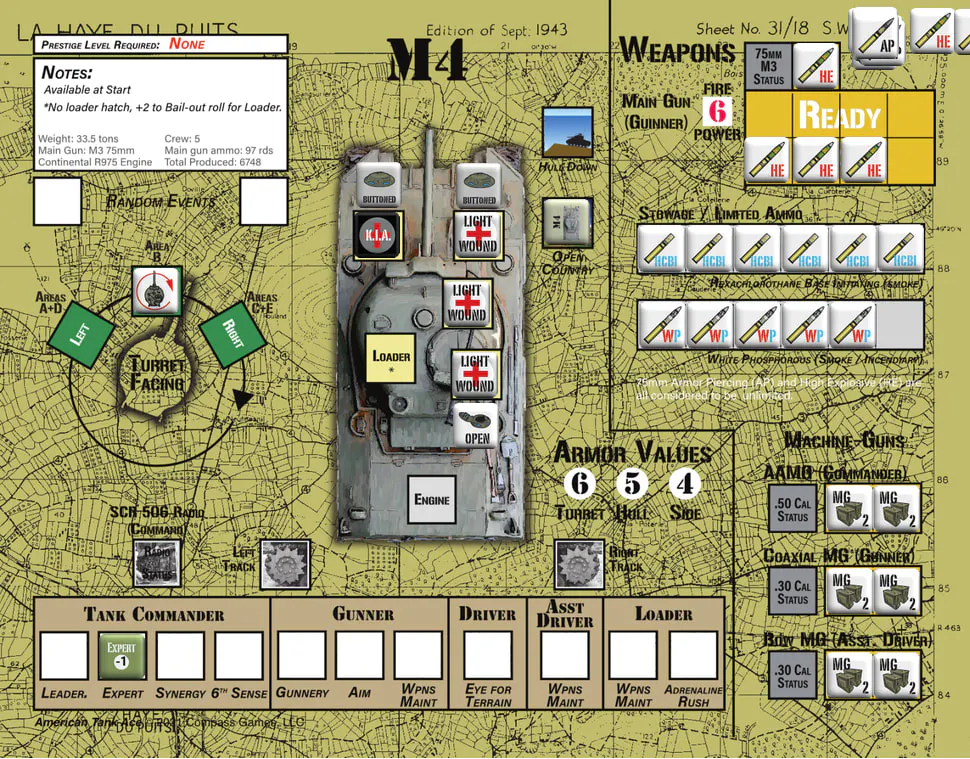
Post Mission
In the aftermath of the harrowing engagement, the surviving crew members of the Sherman tank “Copperhead” received the recognition they rightfully deserved. Each crew member was awarded the Purple Heart for the injuries they sustained in the heat of battle. Their sacrifices stood as a testament to their unwavering dedication amidst the crucible of war. Furthermore, the crew’s participation in their first mission in the European campaign of World War II earned them the European-African-Middle Eastern Campaign Medal, a symbol of their contribution to the wider theater of conflict.
Staff Sergeant Benjamin Caldwell’s exceptional leadership and tactical acumen were also acknowledged. His pivotal role in orchestrating the destruction of the Hetzer and StuG IIIG tank destroyers earned him the Bronze Star, a distinction that reflected his exceptional efforts and unwavering commitment in the face of adversity.
Looking back on the battle, Staff Sgt. Caldwell found himself grappling with the weight of his decisions. The loss of Corporal James “Jimmy” McAllister, the driver, and the grievous injury suffered by Private Michael “Grunt” Thompson, the loader, prompted deep introspection. He contemplated whether a tactical withdrawal, executed earlier in the battle when German reinforcements had initially arrived, could have spared their lives. The somber reflection was a poignant reminder of the complex calculus of command decisions in the midst of a chaotic and rapidly evolving battlefield.
As the crew grappled with the realities of war, the loss of their driver and the significant injury to their loader marked a poignant shift in their journey. The crew, once a cohesive unit of five, now faced the stark reality of being reduced to only three members so soon after their arrival in Normandy. The challenges that lay ahead would be underscored by their determination to honor the memory of their fallen comrade and to persevere through the trials that awaited them on the battlefields of World War II.
Game Note:
- Each crew member received the Purple Heart for injuries.
- Each crew member received the E.A.M.E. award for their first mission.
- Tank Commander, Staff Sergeant Caldwell, received the Bronze Star for the destruction of 2 vehicles in one mission.
Despite the mission failure, Staff Sergeat Caldwell gains 2 Prestige, 1 each from the Purple Heart and Bronze Star being awarded for the first time.
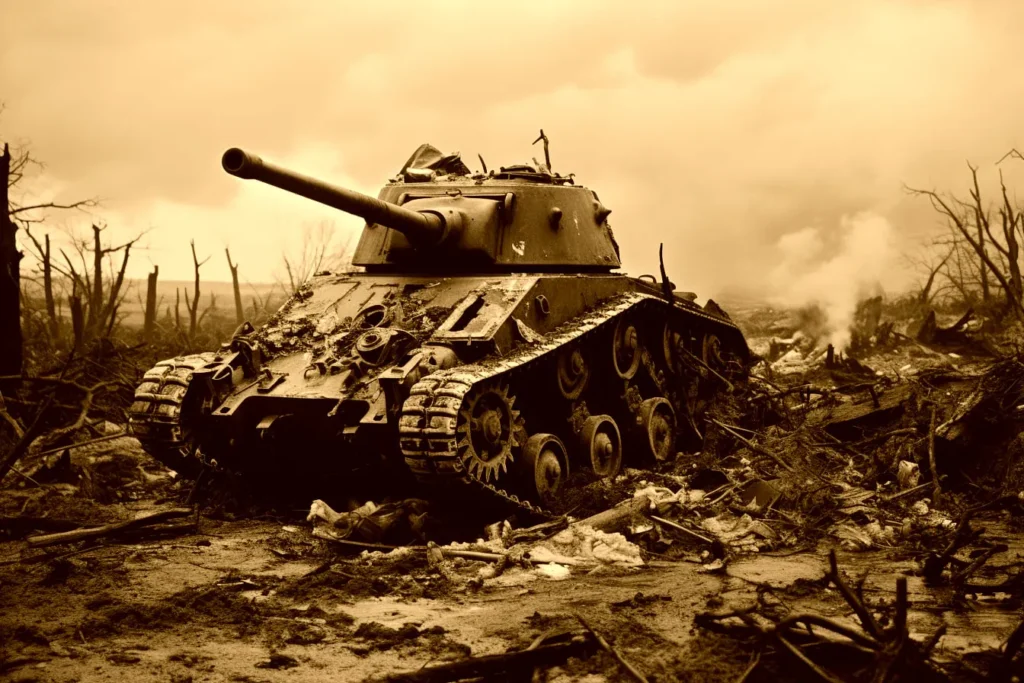
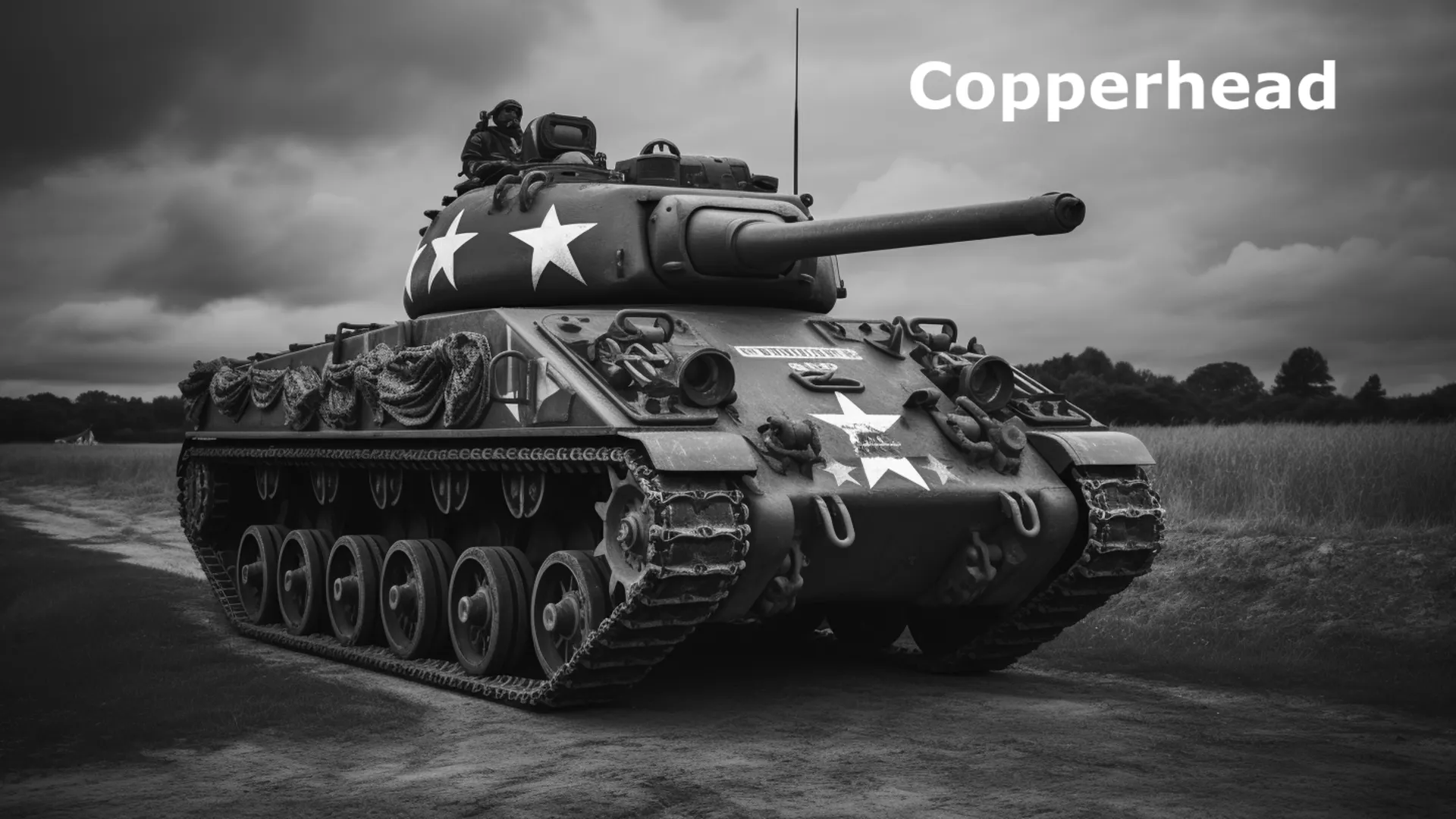
Leave a Reply